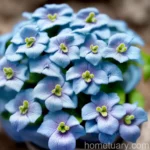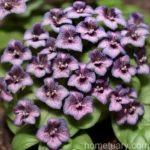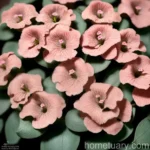Lungwort (Pulmonaria ‘British Sterling’): A Comprehensive Guide for Successful Cultivation
The lungwort plant, scientifically known as Pulmonaria ‘British Sterling’, is a unique, visually appealing, and beneficial addition to any garden or landscape. Recognized for its striking foliage and early spring blossoms, this perennial herbaceous plant has been cultivated for both its aesthetic and medicinal properties for centuries. In this comprehensive guide, we will explore all aspects related to the care, cultivation, and utilization of lungwort, focusing primarily on the ‘British Sterling’ variety.
What is Lungwort (Pulmonaria ‘British Sterling’)?
Pulmonaria ‘British Sterling’ is a notable cultivar of the broader Pulmonaria species, commonly known as lungwort. It is a herbaceous perennial that belongs to the family Boraginaceae. This species is native to Europe, where it thrives in the cool, shaded woodlands. The common name “lungwort” stems from the historical usage of the plant in herbal medicine for treating lung ailments, owing to its lung-shaped spotted leaves.
Plant Characteristics
The ‘British Sterling’ cultivar is distinguished by several characteristic features:
- Foliage: Silver-spotted, lance-shaped leaves with a noticeable silvery sheen.
- Flowers: Bell-shaped flowers, typically in shades of pink, purple, or blue.
- Size: It typically grows to a height of 12-16 inches and spreads to about 18-24 inches.
- Seasonal Interest: It exhibits early spring blooms and maintains attractive foliage throughout the growing season.

Image source: Garden Design
Key Takeaways – Lungwort (Pulmonaria ‘British Sterling’)
Before delving deeper into the specifics of care and cultivation, it’s crucial to understand the essential elements associated with the successful cultivation of Pulmonaria ‘British Sterling’. This entails gaining insights into its cultural requirements, the uses it serves, and the common challenges encountered during its growth.
Culture
The cultural requirements of Pulmonaria ‘British Sterling’ are vital in ensuring its optimal growth and development. This encompasses aspects such as water, sunlight, fertilizer, soil, and pruning.
Uses
Pulmonaria ‘British Sterling’ serves a myriad of purposes, making it a valuable addition to any garden or landscape. Its uses range from ornamental and ecological to medicinal and culinary.
Water
Understanding the water requirements of Pulmonaria ‘British Sterling’ is pivotal in maintaining its health and vigor throughout the growing season.
Sunlight
Sunlight plays a crucial role in the growth and flowering of Pulmonaria ‘British Sterling’. A clear understanding of its sunlight needs is essential for successful cultivation.
Fertilizer
Providing the appropriate nourishment to your Pulmonaria ‘British Sterling’ is vital for fostering robust growth and promoting prolific flowering.
Soil
The soil in which Pulmonaria ‘British Sterling’ is planted significantly impacts its overall health, vigor, and resilience. Evaluating the soil requirements is essential for successful cultivation.
Pruning
Pruning plays a vital role in shaping the growth and appearance of Pulmonaria ‘British Sterling’, enhancing its aesthetic appeal and longevity.
Propagation
Understanding the various methods of propagating Pulmonaria ‘British Sterling’ is crucial for expanding its presence in your garden or sharing it with others.
Container Popularity
Pulmonaria ‘British Sterling’ is well-suited for container cultivation, presenting an excellent option for individuals with limited garden space or those keen on adding diversity to their container gardens.
Common Diseases
Identifying and addressing potential diseases that can affect Pulmonaria ‘British Sterling’ is crucial for maintaining its vitality and appearance.
Disease Diagnosis
Accurate diagnosis of diseases that may afflict Pulmonaria ‘British Sterling’ is pivotal for implementing effective management strategies.
Common Pests
Being aware of the pests that are likely to target Pulmonaria ‘British Sterling’ is essential for preventing and addressing infestations.
Botanist’s Tips
Gaining insights from professional botanists on the successful cultivation of Pulmonaria ‘British Sterling’ can provide valuable guidance for enthusiasts and novice gardeners.
Fun Facts
Exploring the intriguing and lesser-known aspects of Pulmonaria ‘British Sterling’ adds depth and insight into the unique traits of this plant.
Now, let’s explore each of these aspects in-depth for a better understanding of Pulmonaria ‘British Sterling’ and how to care for it to ensure its optimal growth and vitality.
Cultivation and Care of Lungwort (Pulmonaria ‘British Sterling’)
Caring for Pulmonaria ‘British Sterling’ involves attention to its cultural requirements, propagation methods, disease and pest management, and additional insights provided by botanists.
Pulmonaria ‘British Sterling’ Care
Sunlight
Pulmonaria ‘British Sterling’ thrives in partial to full shade, making it an ideal choice for woodland gardens, shaded borders, and other areas with limited direct sunlight. It is essential to provide adequate shade to prevent the delicate foliage from scorching.
Water
Lungwort prefers consistently moist but well-drained soil. Regular watering, particularly during dry periods, helps maintain its vigor and promotes lush foliage and prolific blooming. However, adequate drainage is crucial to prevent waterlogging, which can lead to root rot and other moisture-related issues.
Soil
The ideal soil for Pulmonaria ‘British Sterling’ is rich in organic matter and slightly acidic to neutral in pH. It thrives in fertile, loamy soil with good moisture retention capabilities. It is important to amend the soil with organic matter, such as compost or well-rotted manure, to improve its structure and fertility.
Fertilizer
Applying a balanced, slow-release fertilizer in early spring can provide the necessary nutrients for robust growth and profuse blooming. A fertilizer with a balanced NPK ratio, enriched with micronutrients, can support the overall health and vigor of Pulmonaria ‘British Sterling’.
Pruning
Regular deadheading of spent flowers and removal of any damaged or discolored foliage can help maintain the plant’s appearance and encourage continuous blooming. Additionally, cutting back the entire plant after blooming can prevent self-seeding and promote a tidy, compact growth habit.
Water Requirements
Lungwort typically requires regular watering, particularly during dry spells, to maintain its moisture levels and prevent stress-induced issues. As a general guideline, providing about 1 inch of water per week, either through rainfall or supplemental irrigation, can suffice for its water needs.
Lungwort ‘British Sterling’ Propagation
Pulmonaria ‘British Sterling’ can be propagated through division, seeds, or plantlets. Division of mature clumps in early spring or after blooming is a common method, enabling the expansion of its presence in the garden or sharing with fellow gardening enthusiasts. Additionally, collecting and sowing seeds after flowering, as well as utilizing plantlets that develop on the stems, provide alternative propagation avenues.
Lungwort ‘British Sterling’ in Containers
The adaptable nature of Pulmonaria ‘British Sterling’ makes it well-suited for container cultivation, presenting an attractive addition to patios, balconies, or other outdoor spaces with limited ground area. When cultivating it in containers, it is essential to select a suitable potting mix, provide proper drainage, and monitor its watering needs closely to ensure its optimal growth and performance.
Pulmonaria ‘British Sterling’ Diseases and Pest Management
Lungwort is generally resilient to most diseases and pests, particularly when grown in favorable conditions. However, being vigilant for potential issues and adopting preventive measures can help safeguard its health and vitality.
Disease Resistance
Pulmonaria ‘British Sterling’ exhibits good resistance to most diseases, particularly when provided with the appropriate cultural conditions and care. Adequate air circulation, proper watering, and soil maintenance are essential in preventing common diseases such as powdery mildew and leaf spot.
Pest Control
Despite its resilience, Pulmonaria ‘British Sterling’ may occasionally attract pests such as slugs, snails, and aphids. Implementing preventive measures such as physical barriers, organic pest control methods, and vigilant monitoring can help mitigate potential pest infestations and protect the plant from damage.
Pulmonaria ‘British Sterling’ Companion Plants
Lungwort complements a wide array of shade-loving plants, contributing to diverse and visually appealing garden compositions. Shade-tolerant perennials such as hostas, ferns, heucheras, and tiarellas, as well as early spring bloomers like primroses and hellebores, serve as excellent companions for Pulmonaria ‘British Sterling’, enhancing the visual appeal and ecological balance of shaded landscapes.
Botanist’s Tips
Professional insights and tips from botanists and experienced horticulturists can provide valuable guidance for ensuring the successful cultivation of Pulmonaria ‘British Sterling’. Their expertise can offer refined cultivation practices, troubleshooting strategies, and innovative techniques for maximizing the plant’s ornamental and ecological potential.
Fun Facts about Pulmonaria ‘British Sterling’
Discovering intriguing and lesser-known facts about Pulmonaria ‘British Sterling’ adds depth and appreciation for its unique characteristics and ecological contributions. As a forest-edge native with striking foliage and early blooms, it enriches shaded landscapes and provides valuable resources for pollinators and beneficial wildlife.
Resources for Further Exploration
The following external resources provide additional information on the cultivation and care of Pulmonaria ‘British Sterling’, offering insights from horticultural experts, botanical institutions, and reputable gardening sources:
- Royal Horticultural Society (RHS) – Pulmonaria
- The Morton Arboretum – Lungwort
- Missouri Botanical Garden – Pulmonaria
- University of Wisconsin-Madison Extension – Lungwort
- Ohio State University Extension – Lungwort for Shade Gardens
These resources encompass a range of valuable information, including detailed plant profiles, cultivation recommendations, ecological significance, and specific considerations for successful lungwort cultivation.
By leveraging these resources, enthusiasts and gardeners can further enhance their knowledge and proficiency in caring for Pulmonaria ‘British Sterling’ and widen their understanding of its ecological and horticultural significance.
Conclusion
Pulmonaria ‘British Sterling’ stands out as an exceptional addition to shaded gardens and woodland landscapes, offering a compelling combination of ornamental beauty, ecological benefits, and historical significance. Its striking foliage, early spring blooms, and adaptable nature make it a highly desirable plant for both beginner and seasoned gardeners.
Understanding the cultural requirements, propagation methods, disease and pest management, and additional insights provided by botanists and external resources can significantly contribute to the successful cultivation of Pulmonaria ‘British Sterling’. By incorporating these elements into the care and maintenance of this distinctive plant, enthusiasts can harness its ornamental and ecological potential, enriching their gardens and contributing to the biodiversity and visual allure of their outdoor spaces.
[Disclaimer: The information provided in this guide is based on horticultural practices and cultural recommendations for Pulmonaria ‘British Sterling’. It is advisable to refer to local gardening guidelines and professional advice based on regional conditions and specific plant requirements.]















